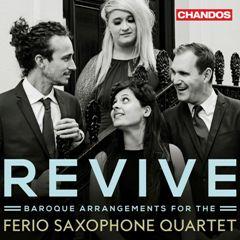Ferio Saxophone Quartet - Revive: Baroque Arrangements for Saxophone Quartet (2018)
Ferio Saxophone Quartet - Revive: Baroque Arrangements for Saxophone Quartet (2018)

Henry Purcell 1. Abdelazar, Z. 570, II. Rondeau Johann Sebastian Bach 2. Orchestral Suite No. 3 in D Major, BWV 1068, II. Air Prelude & Fugue in F Minor, BWV 857 3. Prelude 4. Fugue Prelude & Fugue in G Minor, BWV 885 5. Prelude. Largo 6. Fugue 7. Orchestral Suite No. 2 in B Minor, BWV 1067 VII. Badinerie 8. "Hunt Cantata" BWV 208, IX. Aria. Schafe können sicher weiden Brandenburg Concerto No. 3 in G Major, BWV 1048 9. Allegro 10. Adagio 11. Allegro George Frideric Handel 12. Sarabande, Fourth movement from Suite, HWV 437 Water Music, Suite No. 2 in D Major, HWV 349 13. Alla Hornpipe. Allegro 14. Bourrée. Presto 15. Minuet II. Andante William Byrd 16. Pavan and Gigue "The Earl of Salisbury" Johann Sebastian Bach 17. Fugue, BWV 578 Arcangelo Corelli 18. Concerto grosso in G Minor, Op. 6 No. 8, III. Adagio - Allegro Johann Sebastian Bach Concerto in the Italian Style in F Major, BWV 971 19. [ ] 20. Andante 21. Presto Ferio Saxophone Quartet: -Huw Wiggin, soprano saxophone -Elli McMurray, alto saxophone -José Banuls, tenor saxophone -Shevaughan, Beere baritone saxophone
For its second album on Chandos, the young Ferio Saxophone Quartet presents a set of unique arrangements of milestones from the baroque repertoire, from Corelli via Bach to Handel.
Including many premiere recordings, these fresh interpretations, full of flair and vitality, played on instruments that combine elements of brass and woodwind, bring the tunes and counterpoint to a fascinating new register. The Ferio Quartet plays with power, warmth, and dexterity. ---chandos.net
The Ferio Saxophone Quartet’s disc of Baroque arrangements for saxophone quartet, REVIVE, is gloriously enjoyable. Listen more closely, and the skill of both performers and arrangers is clear, all presented in a state-of-the-art recording. REVIVE certainly warrants investigation: cue an interview, then, with Ferio.
First, how did the quartet come into existence? ‘We met at the Royal College of Music where Huw [Wiggin, soprano sax] and José [Bañuls, tenor sax] were studying for their master’s; and Shevaughan [Beere, baritone sax] and Ellie [McMurray, alto sax] were undergraduates. We formed officially in 2012 through friendship with the aim of having fun.
‘Musically we often visit Kyle Horch, our teacher at RCM, who is masterful with all saxophone repertoire. But mostly we look to colleagues and friends whose expertise will help. For example, we had mentoring from Philharmonia bassoonist Robin O’Neill when preparing for REVIVE.’ And why the name? ‘Ferio is a blacksmith term (Fe being the chemical symbol for iron) which loosely means to mould into shape. We liked the idea of something as strong as a metal being in a malleable, maybe even liquid form.’
The spirit of REVIVE seems to be in keeping with the idea of ‘purity’ as quite a modern idea. In the Baroque era, arrangements of others’ compositions were rife (think of Bach’s arrangements of Vivaldi or Marcello). Pardon the pun, but did Ferio set out to blow new air into these pieces? ‘Absolutely. Our intention was really to adhere as much as possible to original compositional intentions but with the contemporary twist of four saxophones. It is all repertoire that works remarkably well in this ensemble. It has always been necessary to arrange works from other instruments and we are passionate about adding to the quartet canon.’
What is really fascinating is that the Ferio Quartet intends the music to sound as if it could have been originally intended for this instrumental line-up, citing the malleability of the sax, an instrument that melds brass and wind. The variety of sound conjured up, from the call-and-response in the Handel Hornpipe (Water Music), to the purity of Byrd is astonishing. ‘The addition of a more open, wider, clarinet mouthpiece with a wood single reed and a brass body (originally similar to an ophicleide) produces a very flexible tone. Because there isn’t much resistance in the mouthpiece or the reed the sound is naturally quite open which is why it is easy to bend the tone. This means that it is possible to imitate tonal qualities of other instruments through using your own mouth, throat and resonating cavities. The timbral qualities of the saxophone are often paralleled to those of the human voice because they are both so harmonically rich.’ ---Colin Clarke, rhinegold.co.uk
download (mp3 @320 kbs):








